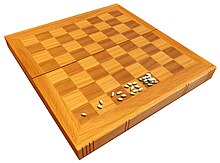
The wheat and chessboard problem (sometimes expressed in terms of rice grains) is a mathematical problem expressed in textual form as:
If a chessboard were to have wheat placed upon each square such that one grain were placed on the first square, two on the second, four on the third, and so on (doubling the number of grains on each subsequent square), how many grains of wheat would be on the chessboard at the finish?
The problem may be solved using simple addition. With 64 squares on a chessboard, if the number of grains doubles on successive squares, then the sum of grains on all 64 squares is: 1 + 2 + 4 + 8 + ... and so forth for the 64 squares. The total number of grains can be shown to be 264−1 or 18,446,744,073,709,551,615 (eighteen quintillion, four hundred forty-six quadrillion, seven hundred forty-four trillion, seventy-three billion, seven hundred nine million, five hundred fifty-one thousand, six hundred and fifteen, over 1.4 trillion metric tons), which is over 2,000 times the annual world production of wheat.[1]
This exercise can be used to demonstrate how quickly exponential sequences grow, as well as to introduce exponents, zero power, capital-sigma notation, and geometric series. Updated for modern times using pennies and a hypothetical question such as "Would you rather have a million dollars or a penny on day one, doubled every day until day 30?", the formula has been used to explain compound interest. (Doubling would yield over one billion seventy three million pennies, or over 10 million dollars: 230−1=1,073,741,823).[2][3]
- ^ In the period 2020–21 this was an estimated 772.64 million metric tonnes, "Global Wheat Production Statistics since 1990". Retrieved 2022-05-25.
- ^ "A Penny Doubled Every Day for 30 Days = $10.7M" – via www.bloomberg.com.
- ^ "Doubling Pennies". Mathforum.org. Retrieved 2017-08-09.
